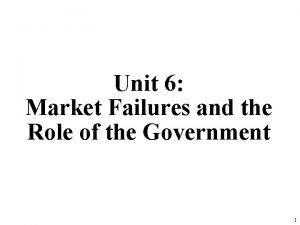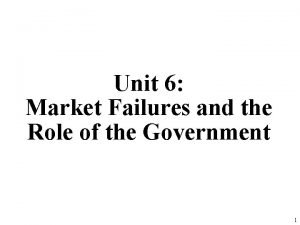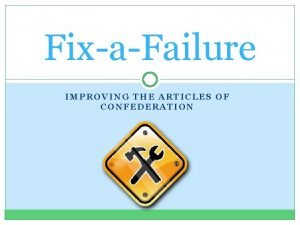Successes and failures of the euro The first
















- Slides: 16

“Successes and failures of the euro: The first 20 years” Prof. Jeffrey Frankel, Harvard Kennedy School Panel on the 20 th Anniversary of the Euro E 51 -345, Tang Center, MIT 11: 30 am-1 pm, Thursday, Jan. 17, 2019

Views differed on the two sides of the Atlantic concerning the prospects for success of the euro. • American economists tended to be skeptical, • E. g. , Feldstein (1997), • on the grounds that the prospective members did not meet the criteria for an Optimum Currency Area. • E. g. , Eichengreen (1992). • European countries lacked the necessary: • • degree of trade integration, cyclical correlation, labor mobility, and fiscal federalism. 2

Europe: We are going ahead anyway. • They de-emphasized the OCA criteria. • But they identified some other vulnerabilities that had not received much attention in the academic literature. • The architects of Maastricht correctly identified the problem of moral hazard in national fiscal policy, • responding to concerns of German taxpayers. • They tried hard to address the problem • by adopting the Maastricht fiscal criteria, • the so-called “no bail-out clause”, • and later the Stability and Growth Pact. • A few European economists even flagged correctly the need for pan-euro banking regulation if the project were to be successful. 3

Successes (four) 1. The transition from 11 individual currencies to the euro in January 1999 was smooth. 2. The euro instantly became the world’s #2 international currency. 3. The incentive of being admitted to the club led to favorable reforms in many aspiring member countries, • particularly outer-periphery countries joining subsequently to 2002. 4. The union survived the euro crisis intact with all 19 members (so far) • contrary to predictions that Greece would have to drop out. 4

Failures (six) 1. The feared asymmetric shocks materialized. a. Ireland, for example, in 2004 -06 needed a tighter monetary policy than the European Central Bank was prepared to set, because it was experiencing a housing bubble and economic overheating. b. Conversely, during 2009 -2013, Ireland needed an easier monetary policy than the ECB was prepared to set, because it was in steep recession. 2. Large net capital flows to periphery countries during the 1 st decade were viewed as signs of efficiency-improving financial integration. 5

That high-debt countries did not have to pay penalty interest rates (1999 -2007) should have been a signal that moral hazard had not been solved. Figure 1: 10 -year government bond yield spreads (relative to Germany) for selected EMU countries Source: Goldman Sachs Global Investment Research, Jan. 16, 2019 6

3. The fiscal rules proved un-enforceable. • Virtually all euro members soon violated the 3% deficit rule • including Germany. • Governments repeatedly asserted that future fiscal targets would be met, assertions that could only be maintained via over-optimistic forecasts. • Frankel & Schreger (2013). • Governments (1999 -2008) never forecast a budget deficit > 3% GDP, • even though they had them, often in successive years. • See Figure 2. 7

Fig. 2 -- In the euro countries which are subject to SGP rules, the optimism bias was reflected in the practice of never officially forecasting next year’s budget deficit > 3% of GDP, even though such deficits recurred. Forecasts of budget balances and actual realizations, as % of GDP, among euro-area countries, pre-2008 Official government forecasts Private forecasts (Consensus Economics) Actual realized budget balances Source: Frankel & Schreger, 2016, "Bias in Official Fiscal Forecasts: Can Private Forecasts Help? “ NBER WP 22349. 8

In some areas, the leaders really did score “own goals. ” 4. Despite the global recession, the ECB mistakenly raised interest rates in July 2008 and again, twice, in 2011. 5. The Greek crisis (early 2010), was not handled well. • The troika (ECB, EU Commission & IMF) might have contained the forest fire. Instead it spread. • Mistake #1: Failure of European leaders to send Greece to the IMF promptly. • They thought that the history of EM crises could not apply to a euro member. • Mistake #2: Refusal to write down Greek debt in 2010, despite Debt Sustainability Analysis showing debt/GDP path to be explosive • even with stringent fiscal austerity. 9

6. The emphasis on austerity was mistaken, applied especially to Greece but to other countries as well. • More specifically, the troika in 2010 and thereafter under-estimated the fall in GDP that would follow from fiscal austerity in the periphery. • Blanchard & Leigh (2013): the underestimation of the severity of the recessions took the form of underestimation of fiscal multipliers. • See Figure 3. 10

Fig. 3 -- The bigger the fiscal contraction, the bigger the GDP loss relative to what had been officially forecast, in the EU 2010 -11. => True multipliers > than multipliers that IMF had been using. Europe: Growth Forecast Errors vs. Fiscal Consolidation Forecasts Note: Figure plots forecast error for real GDP growth in 2010 and 2011 relative to forecasts made in the spring of 2010 on forecasts of fiscal consolidation for 2010 and 2011 made in spring of year 2010; and regression line. From Blanchard & Leigh, 2014, “Growth Forecast Errors and Fiscal Multipliers, ” American Economic Review.

As a result, fiscal austerity did not achieve its financial goal of putting Greece & others onto sustainable debt paths, • even leaving aside the economic cost of the recession and the political cost of associated populist anger. • To the contrary, the fall in GDP was greater than any fall in debt, with the result that debt/GDP ratios rose at accelerated rates. • See Figure 4. • Fatás & Summers (2017): fiscal austerity may have exacerbated debt/GDP paths not just in the short run but even in the long run. 12

Fig. 4: With austerity, debt/GDP ratios continued to rise sharply: Declining GDP outweighed progress on reduction of budget deficits. 200 Public Debt (% GDP) 180 160 France Germany Greece Ireland Italy Portugal 140 120 100 80 60 40 Spain 20 0 19901991199219931994199519961997199819992000200120022003200420052006200720082009201020112012201320142015 . From Remi Bourgeot, Fondation Robert Schuman. Data source: IMF WEO, October 2014.

Bottom line: Since 2000, Greece & periphery have shown pro-cyclical or destabilizing fiscal policy (positive correlation of G & GDP). Figure 5: Correlations between cyclical components of government spending & GDP, 2000 -2016 Frankel (2017). Updated from Frankel, Vegh & Vuletin, 2013, “On Graduation from Fiscal Pro-cyclicality, ” Journal of Development Economics. Thanks to Jose Andree Camarena Fonseca. The cyclical components of spending and GDP were computed using a HP filter with λ = 6. 25 and expressed as percentage deviations from the trend. For each country, the HP filter was applied exclusively to the common sample of the two variables (i. e. , considering only the years for which data for both were available) so that any start-/end-of-sample bias of the HP filter would apply symmetrically to both. In addition, forecasts in the out-years until 2022 were included in both series before applying the HP filter.

I will end with three observations on the “plus” side: 1) Spain & other periphery countries – via painful recessions – gradually brought their uncompetitive Unit Labor Costs back down. 15

On the plus side: 2) ECB President Mario Draghi warrants top marks for successfully walking the tightrope between the German need for discipline and the Mediterranean need for accommodation • most famously for the brilliant sentence (July 2012), that the ECB would do “whatever it takes. ” • He will be hard to replace. 3) Public opinion polls in recent years have shown the euro to be highly popular (64% in Nov. 2018). • So there may be hope after all! 16
 Successes and failures of the five year plans
Successes and failures of the five year plans John cabot successes
John cabot successes Failure title
Failure title Unit 6 four market failures
Unit 6 four market failures Unit 6 four market failures
Unit 6 four market failures Articles of confederation fail
Articles of confederation fail Engineering ethics failures
Engineering ethics failures Vsi calibrated leak
Vsi calibrated leak Why did the articles of confederation fail
Why did the articles of confederation fail Problems with the articles of confederation
Problems with the articles of confederation Rpc semantics in the presence of failures
Rpc semantics in the presence of failures Chapter 7 section 1 guided reading
Chapter 7 section 1 guided reading Pitot static failures
Pitot static failures Define market failure
Define market failure Demand-side market failures occur when
Demand-side market failures occur when Cloud security failures
Cloud security failures Genghis khan
Genghis khan






























